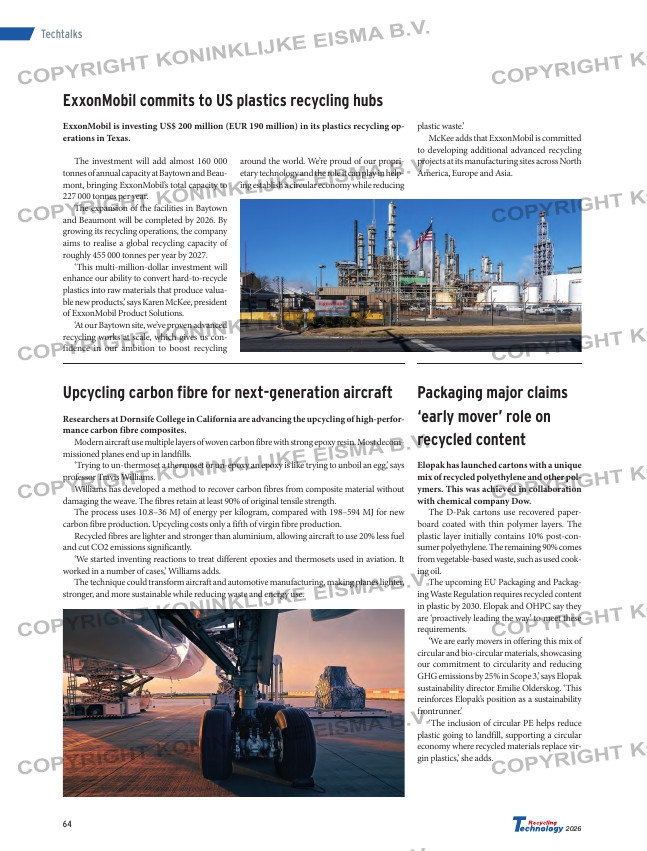Page 64 from: Recycling Technology edition 2026

64
2026
Techtalks
Packaging major claims
‘early mover’ role on
recycled content
Elopak has launched cartons with a unique
mix of recycled polyethylene and other pol-
ymers. This was achieved in collaboration
with chemical company Dow.
The D-Pak cartons use recovered paper-
board coated with thin polymer layers. The
plastic layer initially contains 10% post-con-
sumer polyethylene. The remaining 90% comes
from vegetable-based waste, such as used cook-
ing oil.
The upcoming EU Packaging and Packag-
ing Waste Regulation requires recycled content
in plastic by 2030. Elopak and OHPC say they
are ‘proactively leading the way’ to meet these
requirements.
‘We are early movers in offering this mix of
circular and bio-circular materials, showcasing
our commitment to circularity and reducing
GHG emissions by 25% in Scope 3,’ says Elopak
sustainability director Emilie Olderskog. ‘This
reinforces Elopak’s position as a sustainability
frontrunner.’
‘The inclusion of circular PE helps reduce
plastic going to landfill, supporting a circular
economy where recycled materials replace vir-
gin plastics,’ she adds.
Upcycling carbon fibre for next-generation aircraft
Researchers at Dornsife College in California are advancing the upcycling of high-perfor-
mance carbon fibre composites.
Modern aircraft use multiple layers of woven carbon fibre with strong epoxy resin. Most decom-
missioned planes end up in landfills.
‘Trying to un-thermoset a thermoset or un-epoxy an epoxy is like trying to unboil an egg,’ says
professor Travis Williams.
Williams has developed a method to recover carbon fibres from composite material without
damaging the weave. The fibres retain at least 90% of original tensile strength.
The process uses 10.8–36 MJ of energy per kilogram, compared with 198–594 MJ for new
carbon fibre production. Upcycling costs only a fifth of virgin fibre production.
Recycled fibres are lighter and stronger than aluminium, allowing aircraft to use 20% less fuel
and cut CO2 emissions significantly.
‘We started inventing reactions to treat different epoxies and thermosets used in aviation. It
worked in a number of cases,’ Williams adds.
The technique could transform aircraft and automotive manufacturing, making planes lighter,
stronger, and more sustainable while reducing waste and energy use.
ExxonMobil commits to US plastics recycling hubs
ExxonMobil is investing US$ 200 million (EUR 190 million) in its plastics recycling op-
erations in Texas.
The investment will add almost 160 000
tonnes of annual capacity at Baytown and Beau-
mont, bringing ExxonMobil’s total capacity to
227 000 tonnes per year.
The expansion of the facilities in Baytown
and Beaumont will be completed by 2026. By
growing its recycling operations, the company
aims to realise a global recycling capacity of
roughly 455 000 tonnes per year by 2027.
‘This multi-million-dollar investment will
enhance our ability to convert hard-to-recycle
plastics into raw materials that produce valua-
ble new products,’ says Karen McKee, president
of ExxonMobil Product Solutions.
‘At our Baytown site, we’ve proven advanced
recycling works at scale, which gives us con-
fidence in our ambition to boost recycling
around the world. We’re proud of our propri-
etary technology and the role it can play in help-
ing establish a circular economy while reducing
plastic waste.’
McKee adds that ExxonMobil is committed
to developing additional advanced recycling
projects at its manufacturing sites across North
America, Europe and Asia.
64-65-66-67-68_techtalks2.indd 64 27-08-2025 12:58



